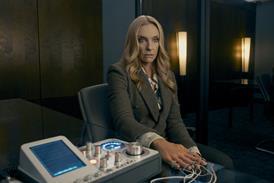Adrian Pennington reports on how consumer demand for a greater auditory experience to match high-definition visuals is helping to drive the rise of 5.1 multichannel audio.
The challenges involved in producing high-definition pictures are well documented, but relatively little attention has been focused on the audio portion of the HD TV experience. While demand has risen in line with greater HD production, the principal call for 5.1 multichannel audio is for US co-productions.
“Clients such as National Geographic, HBO, or Discovery insist on 5.1,” says Chris Roberts, a sound editor at Ascent 142, who recently worked on the surround mix for The Diary of Anne Frank. “However, producers increasingly realise that HD sound can help sales regardless of the original specification.”
The BBC prefers, but does not yet require, a 5.1 mix for productions destined for its HD channels. Sky, however, specifies a Dolby Digital 5.1 deliverable for all commissions for Sky 1, Sky Arts and Sky Real Lives, all of which are available in HD.
Audience demand
“Even for productions originally acquired and broadcast in stereo, there is a growing audience for whom a 5.1 mix is a real selling point for watching DVDs in the home,” says Roberts. “Box sets of series such as Doctor Who or 24, for example, really benefit from being watched in surround sound even if they were originally broadcast in stereo.”
The advantage for producers thinking of delivering a soundtrack for an HD picture is that, in contrast to HD picture acquisition, nothing needs to change in the production process. A 5.1 mix is built entirely in post, from recordings made in the usual way.
“The best advice is to keep it simple and deliver as clean a dialogue track as possible,” says Chris Graver, BBC post production dubbing mixer, who produced the 5.1 mix for Oceans and is speaking on the subject at Broadcast Video Expo’s (BVE) post seminars on 17 and 18 February. “If you’re in a unique location and the sound recordist has the time, then additional wild tracks can be useful, but the focus should be on the dialogue.
“Never record dialogue with a 5.1 microphone, because the background noise means it won’t cut together and you’ll get hit by a big ADR (Additional Dialogue Recording) bill,” advises Ascent’s Roberts.
Dialogue is handled almost like a traditional stereo project, although any imperfections in the original recording will be heightened in 5.1, so additional ADR may be needed. Typically, the dialogue will be placed in the central speakers with effects layered in each of the six speaker channels.
“Producing 5.1 can be as simple as making music come out of different speakers,” explains Blue dubbing mixer Phitz Hearne, whose latest 5.1 project was King Lear for C4, Japan’s NHK and New York’s WNET. “But if you want to use the channels artistically, to engulf the audience and place them in the centre of the action, then that’s when you can begin to create a much more believable soundtrack.”
Additional dialogue can add detail to characters in the background or help create an impression of characters off-screen. The sound artist has an array of effects discs to build texture around the image. This can be supplemented by foley recordings, typically to highlight human action. The .1 of the six channels is intended for low frequency effects, affording extra impact to explosions, for example.
“The potential is vast,” declares Alan Sallabank, Ascent 142’s dubbing mixer, who mixed Tess of the D’Urbervilles and is also speaking at a BVE sound seminar next month. “A good sound editor can look at any point on screen, see a detail and pick it out with sound to involve the audience. The level of detail in an HD picture affords fantastic creative opportunities for us to fill in so much more.”
Audio at the forefront
With no set rules on how to compose a 5.1 mix, it’s much more important for producers to involve audio post early in the production.
“We need to talk to the producer and director as soon as they begin the editorial process so we have time to prepare the details needed to tell the story in the way they want,” confirms Sallabank. “Rather than sound being an afterthought, audio post needs to be involved in pre-production.”
“Communication and preparation help control costs,” agrees Hearne. “It’s much harder and more costly to deliver 5.1 if a producer decides they want that halfway through the mix. We can turn it around, but it’s a missed opportunity to really exploit the creative possibilities that 5.1 can offer. We’re not just asking whether a sound should be louder, but where in the image the sound is placed.”
Simply because the number of elements (or stems) is multiplied, a 5.1 mix will take longer and therefore cost more, although the more time-consuming aspect is preparing the myriad deliverables. Indeed, time spent mixing the deliverables can exceed that spent mastering the original.
“It can be incredibly complicated, particularly for the US,” says Hearne. “HBO, for example, requires a 64-channel deliverable to give it every single option for cutting, remixing or rebuilding into foreign language. The 64 tracks accommodate every element which goes into the 5.1 stems for that programme.”
According to Barbershop Sound mixer Robert Thompson: “Discovery states that only the narration or voice-over is allowed in the centre channel of the audio. National Geographic allows only commentary and sync dialogue for interviews in the centre. For film, anything goes, although the tradition is to keep the dialogue central.”
Thompson recently mixed four hours of Helicopter Mission for Smithsonian, National Geographic and Five. “We mixed the longest version first - in this case the 5.1 for National Geographic - and worked down from that,” he says. “Producing a stereo dub needs equally great care because there’s a danger it can sound worse when folded down from 5.1 than if you began again from scratch.”
What is likely to propel greater demand for 5.1 multichannel audio are consumer expectations of a greater auditory experience to match HD resolutions. According to Roberts: “Producers are more savvy about the potential that sound can have on the programme experience and this will become more apparent as consumers move to larger home theatre-style sets with better speaker systems. In the future, the quality of the soundtrack can be ignored less and less.”
Music Libraries the Trials of high quality Sound mixing
Facilities such as Ascent 142 responded to demand from US and UK clients by upgrading dubbing to HD quality, but other production businesses are taking a more cautious approach.
Music libraries are considering the move to high quality recording, to maximise the potential of their portfolio of music rights.
Audio Network geared up for a sudden rush of 5.1 commissions a year ago, but has been underwhelmed by the lack of response.
“We were expecting a large response, but were amazed to have received only a handful of requests,” says managing director Andrew Sunnucks. “There’s no demand, aside from the games and feature film industry.”
With more than 19,000 tracks it would be “immensely expensive and time consuming” to remix the entire catalogue, says Sunnucks. Instead, Audio Network will open a dedicated 5.1 studio this year to convert any track on request via a TLC Electronics device that automatically builds 5.1 mixes from the stereo original. Additionally, all its new orchestral arrangements will be mastered in 5.1.
“One of the drawbacks is a disagreement about a standard way to mix 5.1,” says Sunnucks. “It’s like trying to mix for a moving target. Since we never know what the requirements of the dubbing engineer will be, it’s best to give them 5.1 stems so they can build the mix themselves.”
This entails laying off discreet 5.1 mixes of elements within the main full mix - for example, a percussion stem, a brass stem, a strings stem and a rhythm stem to allow greater flexibility at the final mix, when dialogue and sound effects are summed with music.
Warren de Wolfe, managing director of de Wolfe Music, adds: “From an audio professional’s point of view, there are still far too many variables considering the individual broadcast experience. For instance, what is the benefit of Dolby TrueHD (the highest possible audio resolution used today) if the surround speakers are tucked down behind the sofa? Or the sub woofer is in the wrong spot?”
Barbershop Sound’s Robert Thompson believes producers are not fully aware of the difficulties a stereo music mix can produce on a 5.1 show. “Since the effects and atmospheres are track laid in 5.1, a stereo music mix won’t fill the room. We can add reverb to help the music fill the room, but when the 5.1 is folded back down to stereo the reverb will make the music sound softer.”

























No comments yet